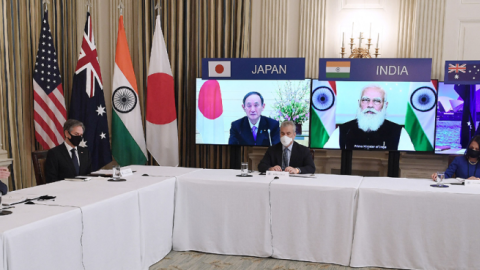Under Xi Jinping, the People’s Republic of China (PRC) has established as its paramount geopolitical objective the replacement of the free and open, rules-based order in Asia with an alternative world order, one that is to be dominated by the interests and values of the Chinese Communist Party (CCP). This decision presents a danger to the entire world, not just to any one state or group of states. For, as US Secretary of State Antony Blinken said at the March 2021 US-PRC meeting in Alaska, the alternative to a rules-based order “is a world in which might makes right and winners take all, and that would be a far more violent and unstable world for all of us.”
In furtherance of its objectives, the PRC is in the midst of a large military build-up, but there is much more. For today’s CCP, political power grows not only from the “barrel of the gun,” as Mao Zedong once put it, but also from cutting-edge technologies. Thus, while Beijing pours billions into artificial intelligence and surveillance tech to impose its new “digital totalitarianism” inside the PRC, from Hong Kong to Xinjiang, it is also using its growing technological prowess to press its larger geopolitical agenda in the Indo-Pacific and beyond. It is weaponizing technology and connectivity, along with trade, finance, and other policy instruments to try to rule the key technologies and industries of the future, as well as to improve its strategic positioning and acquire political power over other countries—for instance, through its bid to dominate other nations’ most sensitive data networks, or via the export of its suite of “social stability” technologies, i.e., the “techno-tyrant’s toolkit.” In all this, the CCP’s intent is to entrench its power and Leninist norms and practices to the extent it can do so beyond the PRC’s borders, and to make other nations, or at the least their ruling elites, beholden to it.
So in addition to the PRC’s militarily destabilizing activities in the West Pacific and incursions into India’s Himalayas, there is also a “geo-technological front.” If Xi’s CCP succeeds at enmeshing other countries in its expanding “PRC sphere of technological influence,” it could unlock and be able to exploit decisive military, economic, diplomatic, and ideological advantages.
The PRC’s many-faceted assault on international order requires a similarly comprehensive and sustained response. Many democratic nations, therefore, have been acting to reimagine and deepen cooperation with one another, including in the geo-tech arena. However, the CCP is aware that the world’s democracies are of many minds about how to respond to it, and the party has always relied on poor coordination among the democracies to advance its aims. Far greater coordinated planning and action—an “alliance of democracies,” as President Biden has called for—will be needed to safeguard and promote democratic leadership over the key technologies and industries of tomorrow, and the ends to which they will be put. In the meantime, the main locus of PRC’s strategic gambits is in Asia, and there, a powerful grouping of Indo-Pacific democracies has emerged to balance against and counter the PRC’s bid for primacy.
This policy memo examines seven areas of cooperation between members of the Quad alliance that would strengthen a technological environment anchored by democratic values:
# Foster a robust democracy-led tech ecosystem in the Indo-Pacific
# Create commercially competitive alternatives to PRC 5G
# Establish a Quad free and secure digital trade agreement
# Coordinate policies to restrict PRC economic involvement in geo-tech and manufacturing competition
# Address PRC freeriding and the illegitimate use of innovation on the “global democratic commons”
# Establish a Quad innovation fund
# Focus on environmental technology


















